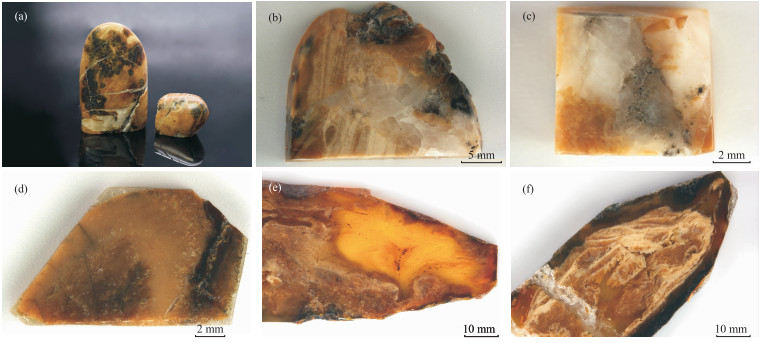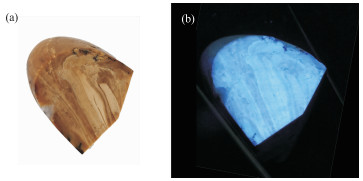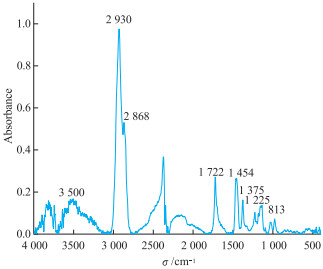Study on Hosting State between Calcite and Matrix in Root Amber from Myanmar
-
摘要:
本研究聚焦缅甸根珀中普遍存在的白色脉状矿物的赋存状态及其与琥珀基体的相互关系。通过常规宝石学测试结合红外光谱分析,确定了根珀样品中黄色-棕褐色区域符合典型缅甸琥珀的产地特征;拉曼光谱显示根珀样品中白色脉状矿物为方解石,黑色颗粒状矿物为黄铁矿;光学显微镜和扫描电子显微镜详细表征了白色脉状方解石与琥珀基体的空间伴生状态,方解石呈现侵入式形态穿插于根珀基体内部结构,即大量微米级的方解石脉存在于根珀黄色-棕色基体中,它们之间的界限未见明显的成分过渡现象。值得注意的是,方解石脉与琥珀基体交界处存在大量破损碎块,这可能是导致根珀透明度较低的一个潜在因素。方解石作为一种稳定的碳源,与有机物琥珀和黄铁矿共存的现象揭示了该品种琥珀埋藏时期的古环境特征,这不仅有助于厘清根珀的形成过程,还能进一步反映古环境的变迁历史。
Abstract:This study aims to explore occurrence state of prevalent white vein-like minerals in root amber from Myanmar and their interrelationship with amber matrix. The results of the conventional gemmological tests and Fourier transform infrared spectroscopy (FTIR) confirmed that the yellow-brown matrix of the root amber samples exhibit the typical provenance characteristics of amber from Myanmar. Raman spectroscopic test results identified the white vein-like minerals as calcite and the black granular minerals as pyrite. Optical microscopic and scanning electron microscopic tests provide detailed characterization of the spatial coexistence of the white vein-like calcite and amber matrix. The calcite exhibits an intrusive morphology, interspersed within the internal structure of the root amber matrix, indicating the presence of numerous micron level calcite veins inside the yellow-brown matrix of amber. There is no compositional transition at boundaries between calcite veins and amber matrix. Additionally, the presence of large amounts of broken fragments are observed at the junction between the calcite veins and amber, which could be a potential factor contributing to low transparency of the root amber. The coexistence of calcite as a stable carbon source, with organic amber and pyrite insights into the paleoenvironmental conditions during burial period of root amber.This not only clarifies the formation process of root amber, but also further reflects the historical changes in paleoenvironment.
-
Keywords:
- root amber /
- gemmological characteristic /
- associated calcite /
- occurrence state /
- Myanmar
-
-
图 1 含白色脉状方解石的缅甸根珀样品:(a)样品FR-1A和FR-1B;(b)样品FR-1A平行双面抛光片;(c)样品FR-1B平行双面抛光片;(d)样品YR-3平行双面薄片;(e)样品LM-4平行双面薄片;(f)样品LM-5平行双面薄片
Figure 1. Root amber samples from Myanmar with white vein-like calcite inclusions: (a) samples FR-1A and FR-1B; (b) parallel double-sided polished slice of sample FR-1A; (c) parallel double-sided polished slice of sample FR-1B; (d) parallel double-sided polished thin slice of sample YR-3; (e)parallel double-sided polished thin slice of sample LM-4; (f) parallel double-sided polished thin slice of sample LM-5
表 1 缅甸根珀样品的基本特征
Table 1 Basic gemmological characteristics of root amber samples from Myanmar
样品编号 RI(点测) 相对密度 荧光特征 FR-1A 1.54 1.22 LW:强蓝白色;SW:中等蓝白色 FR-1B 1.54 1.31 LW:强蓝白色;SW:惰性 YR-3 1.54 1.14 LW:强蓝白色;SW:惰性 LM-4 1.54 1.09 LW:强蓝白色;SW:弱蓝白色 LM-5 1.54 1.20 LW:强蓝白色;SW:弱蓝白色 -
[1] Kharin G S, Eroshenko D V. Amber in sediments of the Baltic Sea and the Curonian and Kaliningrad bays[J]. Lithology and Mineral Resources, 2017, 52(5): 392-400. doi: 10.1134/S0024490217050054
[2] Smith R D A, Ross A J. Amber ground pholadid bivalve borings and inclusions in Burmese amber: Implications for proximity of resin-producing forests to brackish waters, and the age of the amber[J]. Earth and Environmental Science Transactions of the Royal Society of Edinburgh, 2016, 107(2-3): 239-247. doi: 10.1017/S1755691017000287
[3] Girard V, Salpeteur I, Dutta S, et al. An enigmatic piece of amber in the Oligocene of the Assam-Arakan Basin (Eastern India)[J]. Geobios, 2015, 48(1): 1-8. doi: 10.1016/j.geobios.2014.12.001
[4] Zhao T, Peng M, Yang M, et al. Effects of weathering on FTIR spectra and origin traceability of archaeological amber: The case of the Han Tomb of Haihun Marquis, China[J]. Journal of Archaeological Science, 2023(153): 105 753.
[5] 王雅玫. 琥珀宝石学[M]. 武汉: 中国地质大学出版社, 2019. Wang Y M. Amber gemology[M]. Wuhan: China University of Geosciences Press, 2019. (in Chinese)
[6] 林劲畅, 许瑞雪, 李继红, 等. 缅甸根珀的宝石矿物学特征研究[J]. 宝石和宝石学杂志(中英文), 2019, 21(S1): 40-48. Lin J C, Xu R X, Li J H, et al. Gemmological characteristic of root amber from Myanmar[J]. Journal of Gems & Gemmology, 2019, 21(S1): 40-48. (in Chinese)
[7] 涂聪, 钱呈, 陈涛. 缅甸根珀的宝石学特征[J]. 宝石和宝石学杂志(中英文), 2020, 22(4): 13-22. Tu C, Qian C, Chen T. Gemmological characteristic of root amber from Myanmar[J]. Journal of Gems & Gemmology, 2020, 22(4): 13-22. (in Chinese)
[8] 施光海, 代荔莉, 王妍, 等. 缅甸"有点咸"根珀与波罗的海蜜蜡的显微特征对比及意义[J]. 宝石和宝石学杂志(中英文), 2023, 25(4): 42-49. Shi G H, Dai L L, Wang Y, et al. Micro-characteristic of "briny" root-amber from Myanmar versus beeswax-amber from the Baltic Sea and their significance[J]. Journal of Gems & Gemmology, 2023, 25(4): 42-49. (in Chinese)
[9] Li Y, Feng Y, Li Z, et al. Identification of natural, reconstructed, and imitation root amber[J]. Gems & Gemology, 2022, 58(4): 514-517.
[10] Lin S H, Yang T Y, Huang K Y, et al. Pressed amber imitation of "root amber"[J]. Gems & Gemology, 2022, 58(3): 386-387.
[11] Many G, Escoffier N, Perolo P, et al. Calcite precipitation: The forgotten piece of lakes' carbon cycle[J]. Science Advances, 2024, 10(44): eado5924. doi: 10.1126/sciadv.ado5924
[12] 张志清. 基于光谱学特征的琥珀产地溯源应用及其荧光物质研究[D]. 武汉: 中国地质大学, 2021. Zhang Z Q. Spectral characteristics of amber-Their application in provenance determination, and study on fluorescent components[D]. Wuhan: China University of Geosciences, 2021. (in Chinese)
[13] Beck C W, Wilbur E, Meret S, et al. Infrared spectra of amber and the identification of Baltic amber[J]. archaeometry, 2007, 8(1): 96-109. http://www.onacademic.com/detail/journal_1000035226279910_1cce.html
[14] Wolfe A P, Tappert R, Muehlenbachs K, et al. A new proposal concerning thebotanical origin of Baltic amber[J]. Proceedings of the Royal Society B: Biological Sciences, 2009, 276(1 672): 3 403-3 412. http://www.osti.gov/cgi-bin/eprints/redirectEprintsUrl?http%3A%2F%2Ffaculty.eas.ualberta.ca%2Fwolfe%2Feprints%2FAmber_ProcRSocB-2009.pdf
[15] Angelini I, Bellintani P. Archaeometric analyses of glass and amber beads from the Italian Bronze Age[J]. Journal of Raman Spectroscopy, 2005, 36(8), 775-780. http://search.ebscohost.com/login.aspx?direct=true&db=aph&AN=16353524&site=ehost-live
[16] Downs R T. The RRUFF project: An integrated study of the chemistry, crystallography, Raman and infrared spectroscopy of minerals[J]. Journal of Applied Physics, 2015, 42(4): 054 305.
[17] Gunasekaran S, Anbalagan G. Spectroscopic characterization of natural calcite minerals[J]. Spectrochimica Acta Part A: Molecular and Biomolecular Spectroscopy, 2007, 68(3): 656-664. http://www.onacademic.com/detail/journal_1000034112655410_f6d1.html
[18] Gunasekaran S, Anbalagan G, Pandi S. Raman and infrared spectra of carbonates of calcite structure[J]. Journal of Raman Spectroscopy, 2010, 37(9): 892-899. http://www.onacademic.com/detail/journal_1000033872992010_4b44.html
[19] Kleppe A K, Jephcoat A P. High-pressure Raman spectroscopic studies of FeS2 pyrite[J]. Mineralogical Magazine, 2004, 68(3): 433-441. http://www.onacademic.com/detail/journal_1000036673217010_4ef1.html
[20] García-Vallès M, Di Mariano A, Alfonso P, et al. Differentiation between copal and amber by their structure and thermal behaviour[J]. Journal of Thermal Analysis and Calorimetry, 2023, 148(23): 13 027-13 037. http://openurl.ebsco.com/contentitem/doi:10.1007%2Fs10973-023-12333-8?sid=ebsco:plink:crawler&id=ebsco:doi:10.1007%2Fs10973-023-12333-8
[21] Schopf J M. Modes of fossil preservation[J]. Review of Palaeobotany and Palynology, 1975, 20(1-2): 27-53.
[22] Finney A R. Nucleation and dehydration of calcium carbonate[D]. England: University of Warwick, 2014.
[23] Fan Y, Song H, Wang Z, et al. The behavior of pyrite during in-situ leaching of uranium by CO2 + O2: A case study of the Qianjiadian uranium deposit in the Songliao Basin, northeastern China[J]. Ore Geology Reviews, 2024(169): 106 085.
[24] Wang Q, Morse J W. Pyrite formation under conditions approximating those in anoxic sediments I. Pathway and morphology[J]. Marine Chemistry, 1996, 52(2): 99-121.
[25] Meng Q, Hooker J, Cartwright J. Displacive widening of calcite veins in shale: Insights into the force of crystallization[J]. Journal of Sedimentary Research, 2018, 88(3): 327-343.




 下载:
下载:









